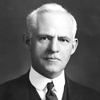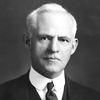Groundbreaking Strategy
“To uncover the causes of poverty and crime and point out the cure”
Fred Goff obeyed the dictum of Cleveland civic architecture designer Daniel Burnham to “make no little plans” as they have “no magic to stir men’s blood.” Less than six weeks after the Cleveland Foundation’s creation, Goff publicly announced that the community trust would undertake as its first act “a great social and economic survey of Cleveland, to uncover the causes of poverty and crime and point out the cure.” The research project, which Goff expected would take two years to complete, would be a way for the foundation, which had no endowment as yet, to make an immediate contribution—by increasing public awareness of the problems facing a community in the throes of rapid urbanization. It would also be an indispensable blueprint to guide grantmaking at that future date when income would be available for distribution.
The Major Cleveland Surveys
Public Education
 Purpose: To remedy the city’s overcrowded, antiquated system of primary and secondary public school education
Purpose: To remedy the city’s overcrowded, antiquated system of primary and secondary public school education
Principal Investigator: Dr. Leonard P. Ayres, a former school superintendent who now worked for the Russell Sage Foundation as director of education and statistics. Ayres subsequently accepted an offer to become vice president for business forecasting at Cleveland Trust and served on the board of the Cleveland Foundation.
Finished Product: 25 reports, published between the fall of 1915 and January 1917
Recommendations and Outcomes: A new superintendent, Frank E. Spaulding, who formerly headed the Minneapolis public schools, was recruited with Ayres’s assistance in 1917. Spaulding ultimately implemented three-quarters of the survey’s recommendations. As the Cleveland Foundation determined in a follow-up investigation conducted in 1923, compulsory attendance to age 16 had been instituted, vocational training had been expanded and special programs for the gifted introduced, teachers’ salaries had been raised and their professional development opportunities enhanced, nine of 11 board seats up for election had been filled by candidates pledged to noninterference in administrative matters, and five school bond issues providing $29 million in revenues had been passed. Although problems with truancy, high dropout rates and the underperformance of students from poor and working-class families persisted, for several decades after the survey’s completion the Cleveland public schools were widely considered an exemplary system. The survey itself was long esteemed as a national model.
Recreation
 Purpose: To analyze the leisure-time needs of adults and children and investigate the ability of existing public, private and profit-oriented recreational outlets to meet those needs
Purpose: To analyze the leisure-time needs of adults and children and investigate the ability of existing public, private and profit-oriented recreational outlets to meet those needs
Principal Investigator: Cleveland Foundation survey director Allen T. Burns, with technical assistance provided by Rowland Hayes, New York City’s recreation secretary
Finished Product: The political controversy over the study’s claim that Cleveland’s mayor turned a blind eye toward prostitution and gambling prompted Burns’s resignation with only three of the contemplated six reports having been published. Begun in late 1916, work on the recreation survey was halted for the duration of World War I. The survey was completed in late 1919 by the foundation’s first full-time director, Raymond Moley.
Recommendations and Outcomes: The survey called upon the Cleveland Board of Education to increase expenditures for recreational programming and accept responsibility for operating the city’s playgrounds. Both recommendations were followed for a time. Other findings resulted in the creation of city-sponsored sports leagues, a separate tax to support the Cleveland Public Library, and the establishment of a Cleveland Recreational Council. Operating under the auspices of the Welfare Federation of Cleveland, the council immediately began pushing for passage of a special tax levy to allow the Metropolitan Park Board to purchase land ringing the city. With 50 influential citizens on the campaign team, whom the council had taken on a guided tour of Bear Mountain Park in New York, the levy passed, and the park board set about assembling what was to become the Cleveland Metroparks.
Criminal Justice
 Purpose: To address the failure of the criminal court system in Cleveland and Cuyahoga County to function swiftly, impartially and without deviation from the public interest, and to determine whether the city’s high incidence of crime was related to this breakdown
Purpose: To address the failure of the criminal court system in Cleveland and Cuyahoga County to function swiftly, impartially and without deviation from the public interest, and to determine whether the city’s high incidence of crime was related to this breakdown
Principal Investigators: Roscoe Pound, dean of the Harvard University Law School, and his colleague, Felix Frankfurter, professor of administrative law and former assistant U.S. attorney for the southern district of New York, supervised the work of a team of researchers.
This team included Reginald Heber Smith, a Boston attorney and future president of the American Bar Association, and Raymond B. Fosdick, the author of respected books on American and European law enforcement and the future president of the Rockefeller Foundation. Felix Frankfurter went on to serve as a distinguished associate justice of the U.S. Supreme Court from 1939 to 1962.
Finished Product: Reports on the survey’s seven areas of inquiry—law enforcement, prosecution, court organization and administration, penal and correctional treatment, psychiatry, legal education, and press coverage—were issued in the fall of 1921, and a 729-page summary volume was published the following year.
Recommendations and Outcomes: Calling the survey “broadly and courageously planned,” The New Republic magazine led a chorus of praise that greeted the published findings of what was America’s first “scientific” examination of the administration of justice. Requests for information about the survey came from around the country and indeed the world, particularly from continental Europe and the United Kingdom.
Received much less positively by the study subjects in Cleveland, the criminal justice survey nonetheless led to new leadership at the city prosecutor’s offices and at the city workhouse, both of which had been singled out for laxity; the creation of the administrative position of chief justice of the county common pleas court; the elimination of a mandatory preindictment court appearance by police that prolonged the scheduling of trials; and the passage of a twice-defeated bond issue that permitted the completion of a new police station and jail on East 21st Street in 1926. Four years later, a modern criminal courts building was erected next door.

Bathing at Gordon Park, c. 1914. A foundation-commissioned recreation survey, completed in 1919, recommended improvements in the variety of wholesome leisure-time activities available to Clevelanders.
Goff had already hired a survey director, Allen T. Burns, whom he recruited from Pittsburgh, where in 1907 the Russell Sage Foundation, a newly formed national philanthropy dedicated to supporting social science research, had commissioned an influential study of living and working conditions in that city’s steel district. Burns had served as executive secretary of a civic commission formed to carry out the recommendations of the Sage survey, which had inspired nearly 100 other municipal studies. None had the scope or objectives of the comprehensive survey envisioned by the Cleveland Foundation’s founder. Unlike many other wealthy philanthropists, Goff aspired to help eradicate the root causes of societal ills, not merely to remediate their symptoms.
Following protocols set forth in the foundation’s Resolution and Declaration of Trust, an oversight body was appointed to supervise Allen Burns. For the next three years the five members of the so-called Survey Committee served as the foundation’s de facto governing board.
Survey Committee Members
- Charles E. Adams, manufacturer, Cleveland Trust director and Survey Committee chairman
- Bascom Little, contractor
- Thomas G. Fitzsimons, steel manufacturer
- Victor W. Sincere, department store manager
- Myrta L. Jones, civic leader
As soon as Goff had revealed the Cleveland Foundation’s ambitious strategy, he, Burns and the Survey Committee were inundated with requests for studies. As a result of the public outcry for solutions to problems ranging from dangerous railroad crossings to socialist fervor among disaffected immigrants, the Survey Committee abandoned Goff’s plan to conduct an all-encompassing municipal study. Within the next decade, foundation board members would choose eight topics they deemed sufficiently compelling to engage the spirited civic debate required to prompt reform. Carried out by teams of respected national authorities, these independent studies were underwritten by Goff, his friends and the Cleveland Trust Company at a cost of more than $200,000. This commitment represented about $2.7 million in today’s dollars.
Survey findings, which were published in hard cover and presented in public forums, received widespread press coverage locally. Even so, several of the surveys, such as the inaugural 1914 study of “poor relief” and a 1920 survey of political unrest among Cleveland’s immigrant populations, yielded only modest results. A proposed study of the Cleveland lakefront, to be undertaken in 1923 with the goal of developing the Lake Erie shoreline into a recreational resource similar to those in Chicago and Toronto, never materialized. The chief recommendation of a 1924 survey of higher education that Western Reserve University and Case School of Applied Science be merged into a single great university to rival those in New York, Boston and Chicago would not be realized for decades. But the three most ambitious research initiatives, which are described in greater detail in the next section, prompted public indignation and political confrontations that in the end led to much-needed overhauls of Cleveland’s systems of public education, recreation and criminal justice. The education and justice studies even garnered national and international attention, respectively, as models of progressive reform.
Because societal uplift is always a work in progress, the surveys’ most enduring contribution was in shaping the mission—and stiffening the political backbone—of the Cleveland Foundation itself. The formative survey years (1914‒1924) established a precedent that inspired succeeding generations of community foundation leaders here and across the nation. Beginning in the turbulent 1960s, Cleveland Foundation directors frequently cited the survey era as justification for stepping anew into the role of civic agenda-setter or problem-solver. In Goff’s commitment to research-action, they found the will and courage to provide urgently needed strategic leadership.

